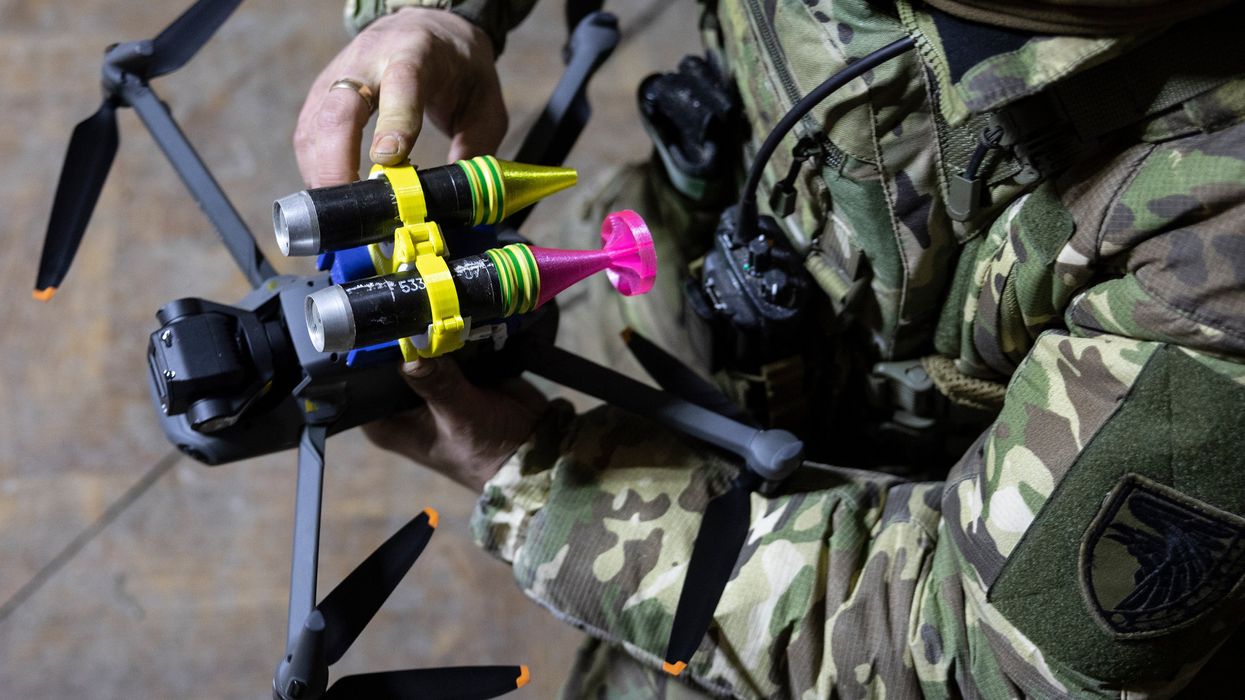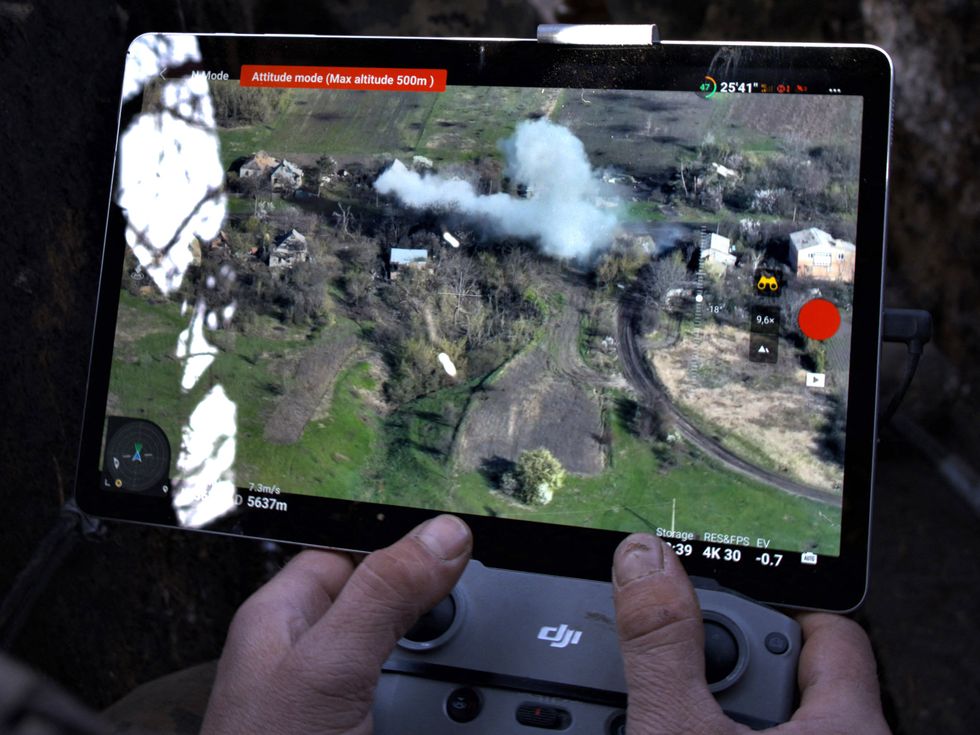Budget Drones in Ukraine Are Redefining Warfare

The war between Russia and Ukraine is making a lot of high-tech military systems look like so many gold-plated irrelevancies. That's why both sides are relying increasingly on low-tech alternatives-dumb artillery shells instead of pricey missiles, and drones instead of fighter aircraft.
This war is a war of drones, they are the super weapon here," Anton Gerashchenko, an adviser to Ukraine's minister of internal affairs, told Newsweek earlier this year.
In early May, Russia attributed explosions at the Kremlin to drones sent by Ukraine for the purpose of assassinating Vladimir Putin, the Russian leader. Ukraine denied the allegation. True, the mission to Moscow was ineffectual, but it is amazing that it could be managed at all.
Like fighter planes, military drones started cheap, then got expensive. Unlike the fighters, though, they got cheap again.
Drones fly slower than an F-35, carry a smaller payload, beckon ground fire, and last mere days before being shot out of the skies. But for the most part, the price is right: China's DJI Mavic 3, used by both Russia and Ukraine for surveillance and for delivering bombs, goes for around US $2,000. You can get 55,000 of them for the price of a single F-35. Also, they're much easier to maintain: When they break, you throw them out, and there's no pilot to be paraded through the streets of the enemy capital.
 Smoke clouds rise on a flat-screen monitor above a struck target, as a Ukrainian serviceman of the Adam tactical group operates a drone to spot Russian positions near the city of Bakhmut, Donetsk region, on 16 April 2023, amid the Russian invasion of Ukraine. Sergey Shestak/AFP/Getty Images
Smoke clouds rise on a flat-screen monitor above a struck target, as a Ukrainian serviceman of the Adam tactical group operates a drone to spot Russian positions near the city of Bakhmut, Donetsk region, on 16 April 2023, amid the Russian invasion of Ukraine. Sergey Shestak/AFP/Getty Images
You can do a lot with 55,000 drones. Shovel them at the foe and one in five may make it through. Yoke them together and send them flocking like a murmuration of starlings, and they will overwhelm antiaircraft defenses. Even individually they can be formidable. One effective tactic is to have a drone loiter" near a point where targets are expected to emerge, then dash in and drop a small bomb. Videos posted on social media purport to show Ukrainian remote operators dropping grenades on Russian troops or through the hatches of Russian armored vehicles. A drone gives a lot of bang for the buck, as utterly new weapons often do.
Over time, as a weapons system provokes countermeasures, their designers respond with improvements, and the gold-plating accumulates.
In 1938, a single British Spitfire cost 9,500 to produce, equivalent to about $1 million today. In the early 1950s the United States F-86 Sabre averaged about $250,000 apiece, about $3 million now. The F-35, today's top-of-the-line U.S. fighter, starts at $110 million. Behold the modern-day fighter plane: the hypertrophied product of the longest arms race since the days of the dreadnought.
In the year 2054, the entire defense budget will purchase just one aircraft," wrote Norman Augustine, formerly Under Secretary of the Army, back in 1984. This aircraft will have to be shared by the Air Force and Navy 3 1/2 days each per week except for leap year, when it will be made available to the Marines for the extra day."
Like fighter planes, military drones started cheap, then got expensive. Unlike the fighters, though, they got cheap again.
Sophisticated tech is more readily available, and with AI advances and the potential for swarms, there's even more emphasis on quantity."
-Kelly A. Greico, Stimson Center
Back in 1981, Israel sent modest contraptions sporting surveillance cameras in its war against Syria, to some effect. The U.S. military took hold of the concept, and in its hands, those simple drones morphed into Predators and Reapers, bomber-size machines that flew missions in Iraq and Afghanistan. Each cost millions of dollars (if not tens of millions). But a technologically powerful country needn't count the cost; the United States certainly didn't.
We are a country of technologists, we love technological solutions," says Kelly A. Grieco, a strategic analyst at the Stimson Center, a think tank in Washington, D.C. It starts with the Cold War: Looking at the Soviet Union, their advantages were in numbers and in their close approach to Germany, the famous Fulda Gap. So we wanted technology to offset the Soviet numerical advantage."
A lot of the cost in an F-35 can be traced to the stealth technology that lets it elude even very sophisticated radar. The dreadnoughts of old needed guns of ever-greater range-enough finally to shoot beyond the horizon-so that the other side couldn't hold them at arm's length and pepper them with shells the size of compact cars.
Arms races tend to shift when a long peacetime buildup finally ends, as it has in Ukraine.
The character of war has moved back toward quantity mattering," Grieco says. Sophisticated tech is more readily available, and with AI advances and the potential for swarms, there's even more emphasis on quantity."
A recent research paper she wrote with U.S. Air Force Col. Maximilian K. Bremer notes that China has showcased such capabilities, including a swarm test of 48 loitering munitions loaded with high-explosive warheads and launched from a truck and helicopter."
What makes these things readily available-as the nuclear and stealth technologies were not-is the Fourth Industrial Revolution: 3D printing, easy wireless connections, AI, and the big data that AI consumes. These things are all out there, on the open market.
You can't gain the same advantage from simply possessing the technology," Grieco says. What will become more important will be how you use it."
One example of how experience has changed use comes from the early days of the war in Ukraine. That country scored early successes with the Baykar Bayraktar TB2, a Turkish drone priced at an estimated at $5 million each, about one-sixth as much as the United States' Reaper, which it broadly resembles. That's not cheap, except by U.S. standards.
Right now the militaries of the world are working on ways to shoot down small drones with directed-energy weapons based on lasers or microwaves.
The Bayraktar was extremely effective at first, but after Russia got its act together with air defense, they were not as effective by so large a margin," says Zach Kallenborn, a military consultant associated with the Center for Strategic and International Studies, a think tank in Washington, D.C. That, he says, led both sides to move to masses of cheaper drones that get shot down so often they have a working life of maybe three to four days. So what? It's a good cost-benefit ratio for drones as cheap as Ukraine's DJIs and for Russia's new equivalent, the Shahed-136, supplied by Iran.
Ukraine has also resorted to homemade drones as an alternative to long-range jet fighters and missiles, which Western donors have so far refused to provide. It recently launched such drones from its own territory to targets hundreds of kilometers inside Russia; Ukrainian officials said that they were working on a model that would fly about 1,000 kilometers.
Every military power is now staring at these numbers, not least the United States and China. If those two powers ever clash, it would likely be over Taiwan, which China says it will one day absorb and the United States says it will defend. Such a far-flung maritime arena would be very different from the close-in land war going on now in Eastern Europe. The current war may therefore not be a good guide to future ones.
I don't buy that drones will transform all of warfare. But even if they do, you'd need to get them all the way to Taiwan. And to do that you'd need [aircraft] carriers," says Kallenborn. And you'd need a way to communicate with drones. Relays are possible, but now satellites are key, so China's first move might be to knock out satellites. There's reason to doubt they would, though, because they need satellites, too."
In every arms race there is always another step to take. Right now the militaries of the world are working on ways to shoot down small drones with directed-energy weapons based on lasers or microwaves. The marginal cost of a shot would be low-once you've amortized the expense of developing, making, and deploying such weapons systems.
Should such antidrone measures succeed, then succeeding generations of drones will be hardened against them. With gold plating.